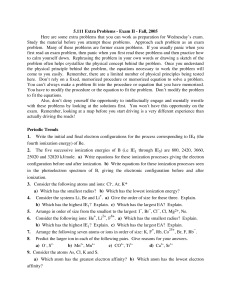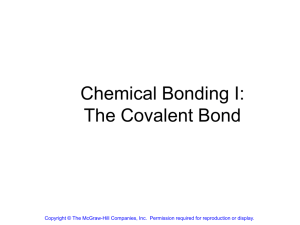Chem 121 Final Exam
advertisement
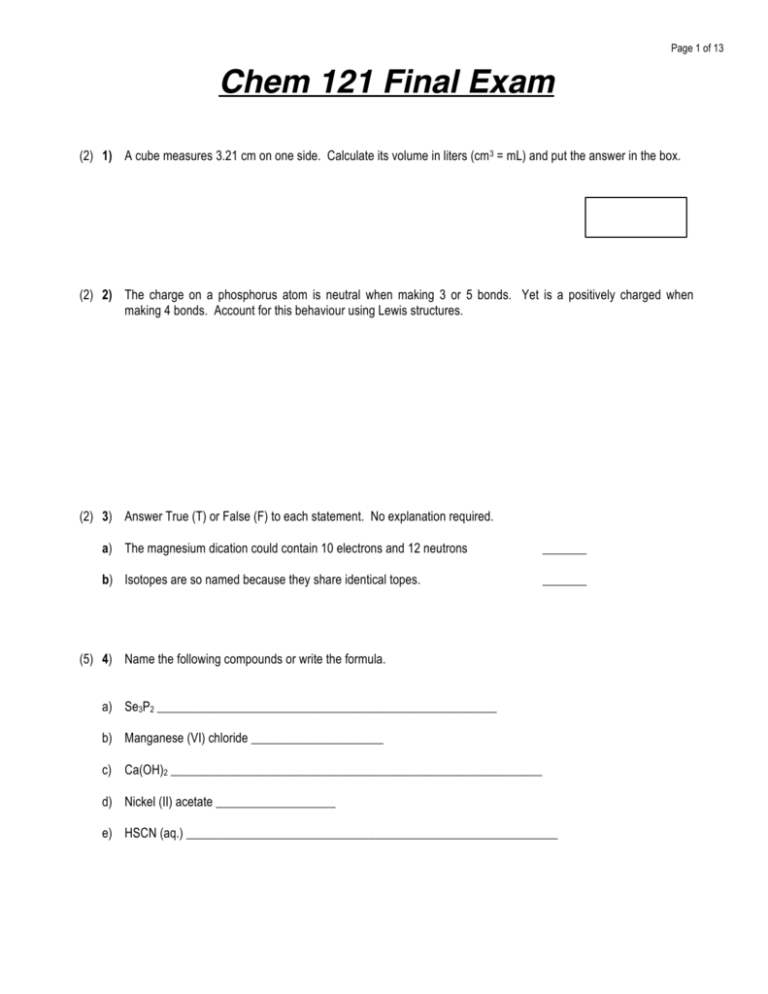
Page 1 of 13 Chem 121 Final Exam (2) 1) A cube measures 3.21 cm on one side. Calculate its volume in liters (cm 3 = mL) and put the answer in the box. (2) 2) The charge on a phosphorus atom is neutral when making 3 or 5 bonds. Yet is a positively charged when making 4 bonds. Account for this behaviour using Lewis structures. (2) 3) Answer True (T) or False (F) to each statement. No explanation required. a) The magnesium dication could contain 10 electrons and 12 neutrons _______ b) Isotopes are so named because they share identical topes. _______ (5) 4) Name the following compounds or write the formula. a) Se3P2 ______________________________________________________ b) Manganese (VI) chloride _____________________ c) Ca(OH)2 ___________________________________________________________ d) Nickel (II) acetate ___________________ e) HSCN (aq.) ___________________________________________________________ Page 2 of 13 5) Methyl isopropyl ether is reacted with HCl (g) (in a 15.1 mL container at 22 °C having a pressure of 4.5 atm). The products of the reaction are 2-chloropropane (C3H7Cl), chloromethane (CH3Cl, 63.8 mg isolated) and water. (3) a) Calculate the limiting reagent in this reaction. Amt. FW (g/mol) 0.113 M, 12.7 mL, 74.12 78.54 (2) b) Calculate the % yield of the reaction. (2) c) How many grams of water were created along with the chloromethane? 63.8 mg 50.5 18.0 Page 3 of 13 (4) 6) The combustion in oxygen of a sample of 2-methyl-2-butene (FW = 70.13 g/mol) produced 1.8 x 1024 atoms of oxygen in the products in a 64% yield. Calculate the mass of the 2-methyl-2-butene sample. (4) 7) An unknown is either NaBr (FW = 102.9 g/mol) or BaBr2 (FW = 297.1 g/mol). The unknown (3.2 g) is stirred with excess AgNO3 to make 0.0215 moles of AgBr (FW = 187.77 g/mol). Calculate the identity of the unknown. Page 4 of 13 (5) 8) A 4.06 g gas sample of ethene (C2H4, FW = 28.1 g/mol) and propene (C3H6, FW = 42.1 g/mol) was reacted with excess ozone (O3, FW = 48 g/mol) to produce 3.4 g of formaldehyde (CH2O, FW = 30 g/mol) plus other products not isolated. In this reaction, ethene produces two moles of formaldehyde in comparison to one mole from the propene. What was the composition in grams of the original mixture of gases? Page 5 of 13 (3) 9) Draw the Lewis structure for the perchlorate anion (ClO4- - the Cl is the central atom) which does not break the octet rule. Put formal charges directly on the atoms. (6) 10) Complete the table below. Indicate any formal charges directly on the atoms. Molecular Formula Lewis Structure with Molecular Geometry Hybridization of Bond Angles Formal Charge on Atoms Name Central Atom XeCl22+ lH4- (2) 11) Complete the boxes by drawing any two resonance structures. Overall Polarity (Yes/No) Page 6 of 13 12) Comment on the boiling point data. Is it true? Why or why not? (3) 13) Consider the positively charged carbon skeleton below. The C1-C2 bond overlap is (sp2-sp2). The C3 atom has bond angles of 109.5° and C4 is sp2 hybridized but has no double bond. Complete the skeleton showing all sigma/pi bonds and hydrogen atoms consistent with the given information above. Page 7 of 13 (10) 14) Choose the most correct response and put the letter in the box. A) When 3.0 L of hydrogen gas (H2) reacts with 1.0 L of nitrogen gas (N2), 2.0 L of gaseous product are formed. All volumes of gases are measured at the same temperature and pressure. What is the formula of the product? (a) N2H6 (b) NH3 (c) NH4 (d) NH (e) N2H3 B) What is the total number of electrons which could be accommodated at n = 4? (a) 18 (b) 16 (c) 8 (d) 32 (e) 9 C) The order of Cl > P > Al > Mg > Cs (read left to right) represents: (a) increasing ionic radii (b) increasing metallic character (c) decreasing electronegativity (d) decreasing electropositivity (e) all of these D) What is the wavelength in nm of radiation with a frequency of 5.75 x 1014 Hz? (a) 522 (b) 425 (c) 575 (d) 325 (e) none of these E) An element has its highest energy orbital being n = 3 and l = 2. The element could be: (a) Ca (b) N (c) Ga (d) Sc (e) none of these F) Consider the two cations Li+ to Ca2+ (a) they are isoelectronic (b) Li+ is smaller (c) Ca2+ is smaller (d) they are the same size (e) none of these G) Hund’s rule helps us to understand: (a) the shapes of orbitals (b) the energy levels of orbitals (c) total number of electrons in an element (d) how electrons fill the Aufbau table (e) the % of s character in hybrid orbitals H) Which of the following would conduct electricity if dissolved in water? (a) BaCl2 (b) CO (c) CCl4 (d) SF4 (e) SO2 I) Which of the following substances can form hydrogen bonds with water? (a) H2S (b) He (c) H3C-NH2 (d) PH3 (e) H3C-CH3 J) Which of the following compounds has the highest boiling point? (a) F2 (b) I2 (c) Br2 (d) Cl2 (e) all boiling points are about the same since the compounds are all non-polar. Page 8 of 13 (4) 15) At room temperature, iron (Fe) has a body-centered cubic (bcc) structure and a density of 7.86 g/mL. Iron can also exist as a solid with a face-centered cubic (fcc) structure (it has a new volume now). Calculate the density of iron in an fcc structure. (4) 16) An unknown metal is determined to have a face-centered cubic structure with the length of a side equal to 409 pm. If a piece of this pure metal weighs 26.225 g and displaces 2.5 mL of water when placed into a graduate cylinder. What is the metal? Page 9 of 13 17) Consider the molecules NO, NO-,CN and CN- . Use only the given molecular orbital energy level below to answer a), b) and c). σ1s < σ1s* < σ2s < σ2s* < π2py = π2pz < σ2px < π2py* = π2pz* < σ2px* (2) a) Calculate the bond order for each molecule. (2) b) Indicate the relative bond length and strength of each molecule. (1) c) Indicate paramagnetic or diamagnetic properties for each molecule. (3) 18) Rank the following intermolecular forces in order of relative strength. (1 to 6 with 1 being the strongest). ____Dipole-Dipole (ie., HCl(g) , HF(g), HBr(g)) ____Dipole-Induced dipole (Water-Octane, Water-Benzene, Water-C2H4) ____Dispersion or London Force (liquid Neon, Liquid Argon, Liquid Xenon) ____Ion-Dipole (methanol-Na+, methanol-Li+, methanol-K+) ____Ion-Induced dipole (Benzene-Na+, Benzene-Mg+2, Benzene-K+) ____Ion-Ion (MgO(s), CaO(s), SrO(s)) Page 10 of 13 19) Given the following balanced equation: 2 NH3 (g) + 3 O2 (g) + 2 CH4 (g) → 2 HCN (g) + 6 H2O (g) (6) a) If exactly 10 g of oxygen is present in a 5 L container at 200°C with the exact quantity of ammonia and methane to react completely, what is the initial total pressure, mole fraction of each reagent and partial pressure of each reagent? (2) b) If the reagents react completely to form the products listed what is the resulting pressure? (2) c) How would the total mass of the products compare to the total mass of the reagents? Justify your answer. Page 11 of 13 (3) 20) Octane (C8H18, FW = 114.2 g/mol, 150 mg) is totally combusted into CO2 (g) and H2O(g) in an internal combustion engine cylinder of volume 0.5 cm3. Calculate the pressure generated in the cylinder at 25°C by these two reaction products. (2) 21) He leaks from a balloon at a rate of 1.4 mL/min. Calculate the rate of Ne leakage out of the same balloon. (2) 22) Would you expect a Neon balloon to “float” in air? Explain why or why not. (3) 23) At 0 °C and 1.0 atm, what pressure would have to be applied to 1 mole of argon to produce a gas density of 1.0 g/mL? (assume isothermal compression and no phase change). Page 12 of 13 (1) 24) Briefly explain why fish find it harder to respire as the water temperature increases. (3) 25a) For the phase diagram given below, explain what process is represented by each arrow, what phases are represented by each letter and the meaning of points (1) and (2). B Pressure → A (2) K N (1) M M Temperature → L M C M Region A represents _________________________________ M Region B represents _________________________________ Region C represents _________________________________ Point (1) represents__________________________________ Point (2) represents__________________________________ Arrow (K-L) represents _____________________________ (1) b) Select a pressure to correspond to 1 atmosphere and indicate on the diagram the Normal Boiling point. (2) c) Does the substance represented by the diagram expand or shrink during freezing. Explain. Page 13 of 13
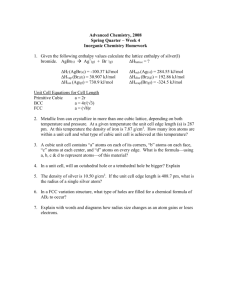


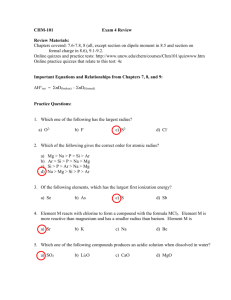



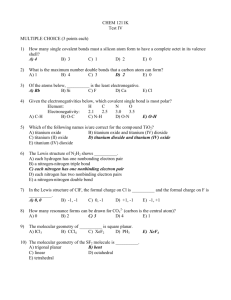
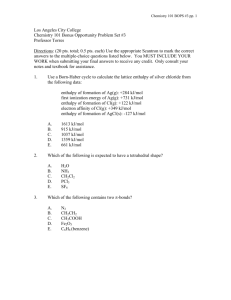
![Solutions 3 (some Chapter 9-10 problems) Chem151 [Kua] 9.48](http://s3.studylib.net/store/data/008277795_1-6308b819854d9c11e64cf2c41c6f9cae-300x300.png)
